Dolphins at Brookfield Zoo Chicago: While Seven Seas underwent updates and renovations, our dolphins were temporarily housed at Minnesota Zoo. To provide the best possible care for the dolphins, Brookfield Zoo Chicago’s animal care staff relocated with them to Minnesota Zoo, providing daily care to the dolphins, and engaging with them in the same manner they do here at Brookfield Zoo Chicago. The dolphins recently returned to Brookfield Zoo Chicago and are currently reacclimating to their habitat.
DOLPHINS IN ACTION TICKETS
Adults: $6.00
Seniors 65 & Over: $4.00
Children 3 to 11: $3.00
Free for Unlimited-Level Members
PURCHASE TICKETS
DOLPHINS IN ACTION SCHEDULE
Effective April 1:
Weekdays: 11:30 a.m., 2:30 p.m.
Weekends: 11:30 a.m., 2:30 p.m., 4:00 p.m.
About Bottlenose Dolphins: Bottlenose dolphins are gray on their back and their flanks and white or sometimes pink on their belly. They have a well-defined rostrum with 18 to 26 teeth on each side of their upper and lower jaws (72 to 104 total). Their eyes are located right behind the spot where the upper and lower jaws meet, and their ears are behind their eyes. Dolphins have three sets of fins: pectoral flippers, dorsal fin, and tail flukes. Dolphins propel themselves through the water by moving their tail in an up and down motion, unlike fish and sharks that move their tails in a side to side motion. Each dolphin has unique markings and coloration on its body and dorsal fin shape. This assists researchers and their keepers identify each individual.
Dolphins are threatened by a variety of natural and human-related activities. Natural factors include predation by large sharks, disease, parasites, exposure to natually occurring biotoxins from harmful algal blooms, changes in prey availability, and loss of habitat. Human-related factors include loss of habitat due to coastal development, noise, pollution, entanglement in hooking by, and ingestion of recreational and commercial fishing gear, as well as injury, death, or behavior changes resulting from boat traffic and human interactions such as illegally feeding wild dolphins. Even though the bottlenose dolphin as a species is listed as being of Least Concern, threats to these animals are increasing, and some populations are currently considered to be Vulnerable, Endangered, or Critically Endangered.
Conservation: Our Sarasota Dolphin Research Program conducts the world's longest-running study of dolphins in the wild. The Zoo administers the Chicago Board of Trade (CBOT) Endangered Species Fund, which supports conservation-oriented research. The grant program attracts dozens of innovative research projects each quarter, which have included dolphin conservation.
Brookfield Zoo Chicago's dolphin program is accredited by the AZA and the Alliance of Marine Mammal Parks and Aquariums.
Meet our dolphins:
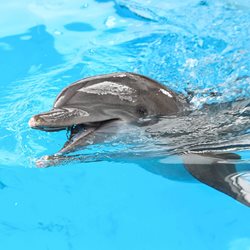 Lucky
Lucky
•50 years old (born January 1974)
•In 2021, Lucky was diagnosed with squamous cell carcinoma—a cancer that has been seen in dolphins in the wild and under human care. He is doing well and continues to receive treatments on an as-needed basis.
•He is the oldest and largest dolphin at Brookfield Zoo Chicago, weighing nearly 500 pounds.
•He is Noelani’s father.
•He enjoys entertaining himself by tossing water in the air and catching it in his mouth, a behavior he has been doing his entire life.
•Lucky was rescued after being found entangled in fishing gear. As a result, he has several scars on his body.
 Tapeko
Tapeko
•42 years old (born January 1982)
•Tapeko arrived at the Zoo in 1991.
•She is the largest of the female dolphins at Brookfield Zoo Chicago, weighing almost 450 pounds.
•She is the mother of Noelani and Allison. She is an experienced mother and exhibits excellent maternal behavior. In the past, Tapeko was a surrogate for her grandson when one of her daughters, who was at the time a first-time mom, could not provide the proper care for her own calf.
•Tapeko enjoys playing with a variety of enrichment items—among her favorites is a basketball.
•She has distinct vertical lines on her melon (forehead) that are visible from her blowhole to her rostrum. Her ventral side (underside) is pink.
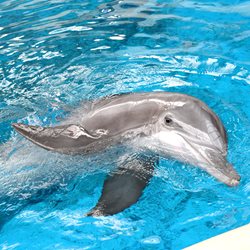 Allie
Allie
•36 years old (April 1, 1987)
•She is very focused on Tapeko and can often be seen swimming with her.
•She spent several years at other accredited facilities and returned to Brookfield Zoo Chicago in 2012.
•She is very inquisitive and playful towards her animal care staff.
•Distinguishing marks on her include faint white lines laterally along her head and dorsal chest, pink coloration on the bottom of her long slender rostrum, and a gray ventral side.
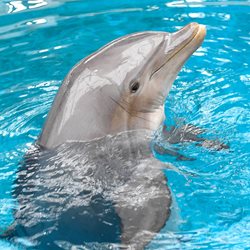 Kai
Kai
•29 years old (born at our Zoo on October 11, 1994)
•Kai spent 16 years at Texas State Aquarium before returning to Brookfield Zoo Chicago in 2022.
•He has taken a liking towards Tapeko.
•He and Lucky, the older male at the Zoo, have made a strong connection and can often be seen swimming together. In the wild, male dolphins form alliances or pair bonds with other males. During breeding times, the males will spend much of their time close to the females that are in estrous. They will use their alliances to fend off other males while they breed with the females.
•He can often be seen upside down while interacting with Zoo guests through the windows in the underwater viewing gallery.
•The coloration on Kai’s dorsal fin is darker than it is on the other dolphins at the Zoo. He also has dark patches on both sides of his body.
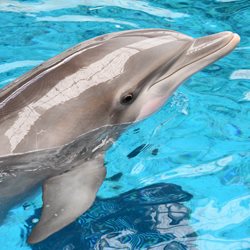 Spree
Spree
•21 years old (born August 16, 2002)
•Spree was born at Minnesota Zoo and first met Brookfield Zoo Chicago’s dolphins when they were temporarily housed in Minnesota during a renovation in 2009. She came to Brookfield Zoo Chicago along with the Zoo’s dolphins once the renovations were completed.
•Her personality has been described as very sassy and she tends to hang out with Noelani and Allison, who are of similar age.
•She has a long slender rostrum and her eyes are wide and pronounced. She also has dark coloration around her eyes like she is wearing a mask. She is petite for her age.
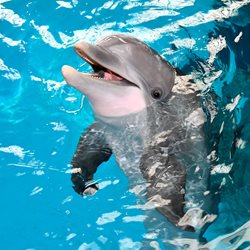 Noelani
Noelani
•20 years old (born at our Zoo on October 30, 2003)
•Her father is Lucky, who recently returned to Brookfield Zoo Chicago in 2021.
•She seems to enjoy innovative training sessions in which her trainers keep her guessing.
•One of her favorite pastimes is sliding across the center deck and slide-out areas at Seven Seas. She is very playful and finds new ways to engage with her enrichment items. Noelani is known for her tail-splash.
•Noelani is Tapeko and Lucky’s daughter and Allison’s sister.
•She has a close relationship with Allison and Spree.
•She will, at times, let her tongue flow out of her mouth while swimming.
•Distinguishing marks include a round melon, short rostrum, and large flukes and dorsal fin in relation to her body size. She has a distinct dorsal fin that has a lasagna noodle shape or rippled trailing edge.
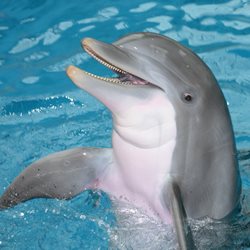 Allison
Allison
•18 years old (born at Brookfield Zoo on November 3, 2005)
•She is the youngest dolphin at Brookfield Zoo Chicago.
•Allison is one of the most playful dolphins in the group and enjoys engaging with her enrichment items.
•Her mother is Tapeko and Noelani is her sister.
•She spends a lot of time mimicking her mother.
•She has one freckle on her tongue, small flukes and dorsal fin in relation to her body size, and a pink ventral side.